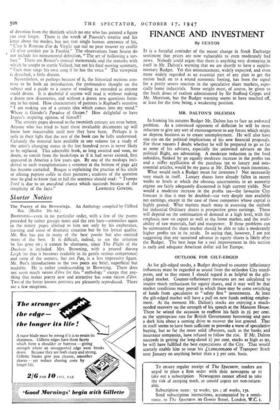Artists on Art
Artists on Art. Edited by Robert Goldwater and Marco Treves. (Kegan Paul. 2Is.) ONE need not, as someone said, be a hen to judge an omelette. Among painters it is in fact often a man's greatest achievement to preserve a kind of innocence about the fundamentals of his art. But little though painters know about painting there is no evidence that any- one else is very much wiser. Arbitrary though their dicta are and ill reasoned their judgements, there is much about which only they can inform us. Only they could ever account, if they would, for the miracle of the moment when the cookery of painting becomes a magical coalescence.
Good painters have rarely concerned themselves with advising the amateur ; by the time they take to writing they have learnt what kind of person they have to deal with. Nor have they, except secretly to relieve their feelings, been much given to correcting the errors of their colleagues. It is significant how little in the excellent anthology of the writings of artists which now appears in England is primarily either admonitory or persuasive in intention. If the great painters who have taken to the pen have any one inten- tion it is to preserve' for men of good will among their successors who happen to find themselves in agreement with them, a map of whatever holy ground they have won, a memorial of the tasks which they would not have forgotten. The pages that he leaves, by their very existence, reveal the revolutionary's concern for continuity and tradition.
When a painter, his hand heavy with responsibility, reaches for his pen, it must be admitted that he is not always quite at his best. Messrs. Goldwater and Treves have made their selection from the most authentic and substantial available texts, and there is a delibera- tion about these extracts in which it is often hard to recognise the men we thought we knew. Almost all are from the painters' own hands ; hearsay and verbal tradition are largely excluded. Continuous passages of some length are given preference. The painter's most characteristic utterances, the pith of his thought, the utterly ince- fensible yet infinitely revealing remarks that he throws out on a moment's impulse and no one eves forgets, are nearly all missing. No doubt it is a good thing • genuine and apocryphal they are quoted often enough. And the seriousness of the result is very welcome.
The editors' method is formal and impartial. They seem almost to avoid the characteristic eccentricity. Turner's single contribution, his remark as a famous evening of talk broke up—" rummy thing, painting "—is spruced up out of all recognition for its appearance at the head of the volume. His rejoinders when a critic called the Snowstorm soapsuds and whitewash and the Rev. Mr. Kingsley told him his mother had liked it are both naturally omitted. But we might surely have been allowed his marginalia to Opie's Lectures "Every glance is a glance for study. . . every look at nature is a refinement upon art." Many readers will And themselves making lists of the omissions that they most resent. And few will be able to discern the principle upon which the selections from Constable, Delacroix and Van Gogh have been made. But no one should read them except in their entirety ; it is enough to be reminded of their existence. It is a virtue of this book that the gaps which each reader notices will form an index to what he holds most precious. There are two or three sonnets of Michelangelo but not the act
of devotion from the thirtieth which no one who has painted a figure can ever forget. There is the wreck of Poussin's treatise and his letter about the modes, but not that single human utterance of his " C'est le Rameau d'or de Virgile que nul tie peut trouver fly ceullir s'il n'est conduit par la Fatalite." The observations from Seurat do not include his monumental definition, "The art of hollowing a sur- face." There are Renoir's ironical memoranda and the remarks with which he sought to startle Vollard, but not his final moving summary, "Each man sings his own song if he has the voice" The viewpoint is detached, a little distant.
Nevertheless, or perhaps because of it, the historical sections con- trive to be both an introduction, the profoundest thought on the subject and a guide to a course of reading as extended as anyone could desire. It is doubtful if anyone will read it without making a dozen new discoveries, and without a dozen new questions form- ing in his mind. How characteristic of painters is Raphael's secretive "I am making use of a certain idea which comes into my mind." Where is Girodet's Paradise of Ossian? How delightful to have Ingres's inspiring opinion of himself!
The seventy pages devoted to the twentieth century are even better. Anyone who has tried to hunt these invaluable documents up will know how inaccessible until now they have been. Perhaps it is only in their light that the rest of the book can be fully understood. Certainly the material here available in one volume for a study of the artist's changing status in the last hundred years is never likely to be replaced. This admirable book, so long awaited and soon, no doubt, to vanish from the bookshops as if it had never existed, first appeared in America a few years ago. By one of the mishaps inci- dental to such transplantations a sentence at the bottom of page 422 has become curtailed. Braque is explaining the practice of his circle of affixing papiers collis to their pictures ; students of the question may be glad to know that in full the sentence should read: " Trompe l'oeil is due to an anecdotal chance which succeeds because of the



































 Previous page
Previous page